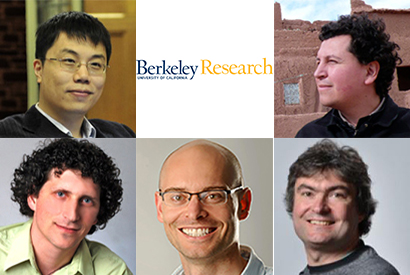Five innovative faculty named Bakar Fellows
Five new faculty innovators have joined the ranks of the Bakar Fellows Program, which supports Berkeley faculty working to apply scientific discoveries to real-world issues in the fields of engineering, computer science, chemistry and biological and physical sciences. The 2015-16 fellows are computer scientists Pieter Abbeel and Michael Lustig, physicist Holger Müller, architect Ronald Rael and chemist Ke Xu.

May 26, 2015
Five new faculty innovators have joined the ranks of the Bakar Fellows Program, which supports Berkeley faculty working to apply scientific discoveries to real-world issues in the fields of engineering, computer science, chemistry and biological and physical sciences.
The program, which started in 2012, now supports 21 early-career faculty, who each receive up to five years of funding to help them introduce their discoveries to the market in areas considered likely to stimulate California’s economy.
The 2015-16 fellows include computer scientists Pieter Abbeel and Michael Lustig, physicist Holger Müller, architect Ronald Rael and chemist Ke Xu. Here’s a closer look at each new fellow’s cutting-edge research:

Pieter Abbeel, an associate professor of electrical engineering and computer science, wants to put a robot in every home. Using novel approaches to robot learning, Abbeel can train machines to do everyday chores that might make mechanical helpers, like the Jetsons’ Rosie the Robot, a reality.
Abbeel’s approach could help robots deal with three big challenges in navigating complex tasks: translatable perception, environmental variability and uncertainty. According to Abbeel, “Right now, robots rely on a lot of input from human operators, which makes complex tasks time-consuming to program. With improved integration of learning from human demonstration and its own trial and error, we can make this process faster, more intuitive and thus, much more versatile.”

Michael Lustig, an assistant professor of electrical engineering and computer science, aims to improve medical services by amping up MRIs. His work in compressed sensing speeds up magnetic resonance imaging by reducing the scan time and enabling dynamic imaging at a higher frame rate and resolution than conventional MRI.
Lustig is working with radiologists at Lucille Packard Children’s Hospital to address the challenges faced by pediatric physicians and their patients. “Kids are particularly vulnerable,” Lustig says. “It is difficult for them to stay still for a long scan. This means that often the diagnostic quality of images is poor, so doctors often use general anesthesia, which adds significant risk, or refer patients to computed tomography, which exposes these vulnerable patients to excessive ionizing radiation. This technology could make a big difference to a lot of young patients. We are making a difference at Lucile Packard Children’s Hospital now, and are about to expand our work to other Bay Area hospitals, such as Oakland Children’s Hospital.”

Holger Müller, an assistant professor of physics, takes finding yourself to a whole new level. His miniaturized multi-axial interferometric inertial sensor can determine its own location without any external cues.
By simultaneously measuring four independent combinations of acceleration and rotation, Müller’s atom interferometer can do amazing things like find materials underground. “The problem,” explains Müller, “is that most of these sensors are huge — about the size of a standard refrigerator. That makes them very expensive and very difficult to use in any practical way. My lab is working on prototypes that are about one inch squared. With a sensor that size, the applications become a lot more interesting.”

In contrast, Ronald Rael, an assistant professor of architecture, wants to scale up. His research in using recycled materials in advanced manufacturing could change the very nature of building construction.
Rael leverages 3D-printing technology, novel geometries and the concept of additive manufacturing to transform used materials like sawdust, tires, salt and pulverized cement into novel building elements. “The versatility of the system is just amazing,” says Rael. “My research shows that we can use a wide variety of local, sustainable materials to explore new architectural applications. Imagine recycled ceramic bricks that can act as passive air-conditioning, and seismically stable structures that anyone could fabricate and assemble on-site. This technology can make sustainable designs more accessible. That’s both exciting and empowering.”
 Ke Xu, the campus’s Chevron assistant professor of chemistry, wants to understand structures at the nano scale. His research on super-resolution microscopy could open new avenues of research in biology and material science.
Ke Xu, the campus’s Chevron assistant professor of chemistry, wants to understand structures at the nano scale. His research on super-resolution microscopy could open new avenues of research in biology and material science.
Xu has extended the resolution of fluorescence microscopy to achieve optical resolution of better than 10 nm, a range previously accessible only through electron microscopy. “By exploiting the largely unexplored spectral dimension of dyes, our research could enable super- resolved microscopy for infinite color channels,” he says. “That could give scientists unprecedented information about the interactions between different molecules in complex systems like biological samples, thus opening up exciting new possibilities for future research and diagnostics. We plan to make our technology work with conventional microscope systems to enable researchers all over the world.”
Learn more about the 2015-16 Bakar Fellows: http://vcresearch.berkeley.edu/bakarfellows/2015-2016-fellows